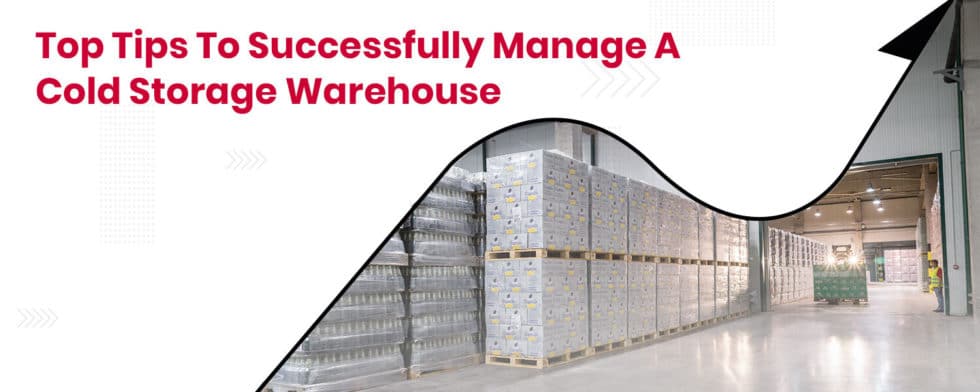Cold storage warehouses were very niche before the pandemic. However, as the demand for online groceries rises, businesses are looking for temperature-controlled warehousing to increase the shelf-life of their products. In particular, the click-and-collect market also saw a boom of 130%, where customers order food online and fetch it from a designated location.
In novice terms, retailers need an efficient cold chain strategy to meet the high volume of orders and keep up with upward customer demands. One of the great benefits of cold storage warehouse is that low temperature lowers the growth of enzymes and chemical changes in food. As a result, the wastage rate slows down to a big extent.
To successfully manage cold storage warehouse, let’s understand how they work.
How Does The Cold Storage Warehouse Work?
The cold storage warehouse aims to maintain an optimum temperature for perishable goods, to stop them from spoiling and extend their life. It is made possible through the consolidation of insulation and an HVAC cooling system.
The cold storage warehouse is geared with coolants, pipes, radiators, and fans to remove heat and replace it with cool air. The components of a cold warehouse are:
The Coolant
The coolant in cold storage warehouses is liquid with low gasification, also known as ‘refrigerant’. The cold warehouses typically use Ammonia, NH3, as it produces a tremendous net refrigerating effect and has low brake horsepower (BHP) of refrigeration of any industrial refrigerants. It circulates through a series of tubes, pipes, and other components.
The Compressor
The compressor is the heart and soul of a cold room’s cooling system. It essentially moves the coolants by raising the pressure and temperature through compression and then pumps the heated coolants into condensers.
The Condenser
As the compressor raises the temperature of Ammonia (coolant), the condenser removes the heat from the coolant/refrigerants. It spreads into the warehouse atmosphere through tubes, fans, and water spray. The condenser changes gas into liquid water at high temperature and pressure, so its heat exchange efficiency determines the efficiency of the whole cold storage warehouse.
The Receiver
Refrigerants, later passing through condensing, change as high-pressure liquid condensates and are stored in the receivers. The receiver maintains the pressure of the complete system and keeps a buffer for situations when more cool air is needed.
The receivers, if needed, transfer refrigerants to an expansion valve, which balances the temperature, pressure, and amount of refrigerants to be emitted into the separator.
The Separator
The separator accumulates refrigerants from the receivers and pumps the refrigerants into another expansion valve, where the flow rate is adjusted before entering into the evaporator.
The Evaporator
The evaporator brings the cooled air into the atmosphere and causes the temperature to drop. The evaporators pass the cold refrigerants through tubes and absorb the heat, and the air leaves the evaporator cold, chilling the warehouse and food.
Top Tips to Manage A Cold Storage Warehouse
Safeguard Workers And Employees
The temperature of cold storage warehouses is usually harmful to humans. Thus employees and workers are more prone to sickness and other health issues. So, as a business owner, it’s your responsibility to safeguard professionals with proper equipment like insulated jackets, pants, and other gear to stay warm in cold conditions.
Employees should get the proper training to familiarize themselves with the cold working conditions, processes, and handling so there are no casualties.
Automate The Process
Automation is a compulsion to sustain the business; if not, you’ll be crushed by the competition because their business would be much more efficient than yours.
Cold storage warehouses require more capital than other warehouses. Fundamentally because of the cost allied to maintaining constant low temperatures, the cost of energy, land, and labour are also rising. Therefore, cold storage businesses are sneaking automation to bring efficiency. Automation minimizes human work, which can be pocket-friendly, and improves cube utilization; employing a pallet racking system and automated storage and retrieval system leads to substantial savings.
Use High-End Technologies And Equipment
Many equipment and technologies are used in a warehouse operation, such as forklifts, computers, sensors, pallet jacks, etc. These machines must be optimized according to the condition to perform functions in cold warehouses.
For example, constant low temperature impacts the battery’s life resulting in a 40% to 50% decline. Hence, higher voltage battery equipment is required in cold warehouses. Another thing, touchscreen equipment is baseless if you operate it by wearing thick gloves. In that sense, touch screens in a cold environment are sensitive enough to respond to glove touch.
Proper Management Of Temperature
Keep a constant check on the temperature of the refrigerators. It is an obvious tip, but many owners make mistakes in managing proper temperature. In addition, the quality and safety of the product are affected by how you manage the warehouse temperature. In a cold storage warehouse, only one product type is not usually preserved, but multiple products are stored at once. So, different perishables require different temperatures to stay fresh.
For example, in a cold storage warehouse, vegetables are stored below 12 °C, milk and dairy products are stored below one °C, meat products are shelved below -2 °C, and ice creams at -23 °C.
Minimize Heat Loss
Minimizing heat loss is essential for achieving energy efficiency and avoiding the atrophy of stock inside cold storage warehouses. After setting up different temperatures in cold storage units, it is crucial to measure whether there is no heat loss. It is challenging to prevent heat transfer from high-temperature areas to cold zones, as new products are brought regularly into cold storage warehouses.
High-speed or strop doors are the primal solutions as they contain refrigerated air and simultaneously allow smooth movement of people, vehicles, and machines to all areas of the station.
Careful While Managing Products
Another factor that retailers often overlook is the precision that needs to be taken while handling products. Often, untrained workers damage the products, tear packaging, and do not maintain proper temperature, resulting in the deterioration of product quality. Always remember slight friction in the temperature of products can hamper their quality.
Conclusion
The consumer demand for fresh food and vegetable delivery at their doorstep makes cold storage warehouses necessary. In the beginning, it may lead to cash burn, but you’ll see a substantial payoff in the long run.
It is an excellent time to invest in warehouses, as they are a vital part of the supply chain and logistics, but many eCommerce retailers skip them because of money constraints. However, if this is you, believe it; that’s not the end because you can partner with NimbusPost to leverage high-end warehouses uniquely designed for your business needs.




